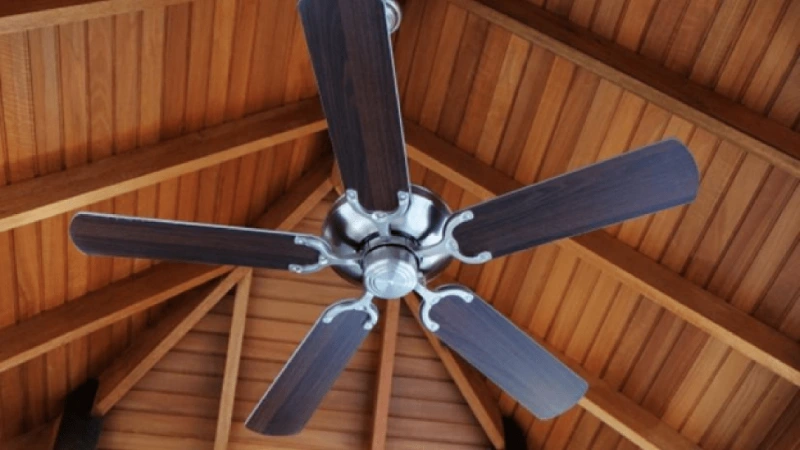
If you look up from wherever you're reading this, there's a good chance you'll see a ceiling fan above you.
Many homeowners don't give these small appliances much thought until they stop working. But a good ceiling fan can make a notable difference in your comfort, the quality of your lighting, and even your electric bill.
To help you better understand how to identify and resolve issues with your ceiling fan, we've put together a series of answers to some common questions, some benefits of ceiling fans, and a list of resources to help you with all your ceiling fan needs.
Why Does My Ceiling Fan Hum?
If your fan is humming, the cause is probably vibration in the motor. However, this can also be caused by loose screws, wiring issues, or an unlubricated fan motor. In most cases, a simple hum won't be cause for alarm and can be ignored. If you've noticed the noise getting louder, Mr. Electric will be glad to look at your fan and offer expert advice about repairing or replacing the unit.
Related Topic: How to Install or Replace a Ceiling Fan
Why Does My Ceiling Fan Shake While It’s Running?
The most common cause of a shaky fan is a loose connection between the unit and the ceiling that leads to an uneven spin. Another common cause is uneven blades, causing unequal weight distribution. Uneven blades can damage your fan's motor, wearing it out sooner than it should. Blades can even be affected by the weight of a tiny amount of dust buildup, so keep them clean.
Related Topic: How to Clean Ceiling Fans Quickly and Safely
My Ceiling Fan Doesn't Work—Do I Need to Replace It?
Not necessarily. If your fan isn't working, see if power is still running to the lights and outlets nearby. Check your electrical panel to see if the circuit breaker has tripped. If everything is okay and your fan still isn't working, it's time to schedule a ceiling fan repair or replacement. Mr. Electric can help you diagnose the problem and, if need be, install a new fan for you.
Related Topic: How to Install a Ceiling Fan
Why Doesn’t My Ceiling Fan Work But the Light Does?
If your ceiling fan light still works, but the fan isn't working, then your fan's motor has likely gone bad. You won't want to undertake a project like that on your own and should turn to a trained electrician to make sure your motor is replaced properly.
Relate Topic: Ceiling Fan Repair
My Ceiling Fan Keeps Tripping the Breaker—Is That Dangerous?
If your fan keeps tripping its circuit breaker, then there is a high chance that you have serious wiring issues such as a short circuit or a ground error. Because the issue could be a short circuit, you'll need to address this immediately with an electrical service professional. A short circuit can cause fire, electrocution, or electrical burning and can't go unattended. Call a professional electrician to come and examine your wiring as soon as possible if you experience this issue.
Which Way Should a Fan Turn in Winter and Summer?
You'll want to run your fan counterclockwise in the summer and clockwise in the winter for optimal temperatures in your home. A counterclockwise fan will generate a downdraft, keeping cool air down and preventing warmer air from getting stagnant. On the other hand, a clockwise-spinning fan will pull air upward and keep your room at a comfortable temperature.
Can I Add Lights to My Ceiling Fan?
If you have a ceiling fan without lighting, you will not have to replace your whole unit as you can add light kits to existing ceiling fans. Many home improvement stores have lighting kit options for existing fans for DIY installation, but electrical work is always best done by trained professionals.
Related Topic: How to Add a Light Kit to Your Ceiling Fan
Do Ceiling Fans Keep You Cool?
Ceiling fans are a practical, economical solution to reducing your air conditioning needs in the summer. By creating a wind chill effect, fans throughout your home can keep you and your family comfortable enough to lower your thermostat temperature by 4-7 degrees F, saving you up to 30% on cooling costs. Still on the fence? As an added bonus, the wind generated by ceiling fans also makes it more difficult for pests to fly, keeping summer pests at bay.
How Do You Find the Perfect Spin?
Stand under your fan, and note the direction in which the blades rotate. (Don’t worry, it doesn’t matter which direction you face.) Remember, you want your blades to spin counterclockwise in the summer, clockwise in the winter. Wrong direction? Turn off the fan and locate the switch on the fan’s base, then simply flick the switch to the opposite direction. Done!
How Can I Select the Right Ceiling Fan?
Choose the right blade size
Want a cooling effect that doesn’t ruffle papers or other items in your home? Opt for larger blade sizes. They offer comparable cooling at a lower velocity than smaller blades. Don’t worry about the number of blades. This will not affect performance.
Properly size and locate fans
Fans should be installed 7-9 feet above floors, 10-12 inches below ceilings and at least 18-24 inches from walls. Select 52-inch fans for rooms up to 400 square feet, 44-inch fans to cover up to 225 square feet, and 42-inch fans for up to 144 square feet. Rooms longer than 18 feet need multiple fans if you intend to cool the whole room.
Find the right features
Selecting easy-to-use models will encourage frequent fan use and reduce your need to use your air conditioning. You should carefully consider features and usage needs such as light intensity, fan speeds, noise level during operation, pull chains, and remote controls.
Remember, you get what you pay for
Splurging a little on a ceiling fan will earn you a model with quieter, smoother operation, more fan speeds, fewer issues, and longer warranties than bargain alternatives.
Ensure safe installation
Professional installation as recommended by the manufacturer is essential to fan lifespan, warranty, and the safety of you and your family. Fans can weigh as much as 50 pounds, so installation isn’t always a piece of cake. Safe installation should include an appropriate UL-listed electrical box made specifically for use with ceiling fans, secure mounting to a ceiling joist (or the use of a mounting bracket), and proper alignment and balancing.
Learn More about Ceiling Fans
Want to learn more about ceiling fans or the services we offer? Explore the following links to find the tools you need to make the right choice when it comes to buying or installing your ceiling fan:
- Ceiling Fan Installation Services
- How to Choose an Outdoor Ceiling Fan
- How to Clean a Ceiling Fan
- How to Install a Ceiling Fan without Existing Wiring or Fixtures
Do You Have Other Questions? We Have Answers
If you have more questions about your ceiling fan or other electric devices in your home, your local Mr. Electric can answer them for you. If the answer to your question involves replacing a fan or installing a light kit, we can get that done for you. To learn more, give us a call or make an appointment online today.
